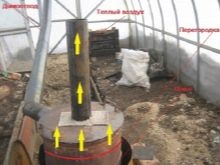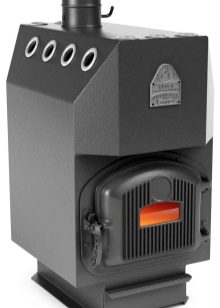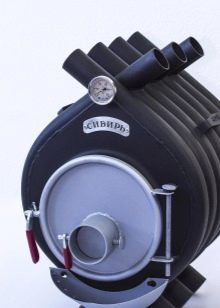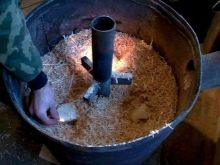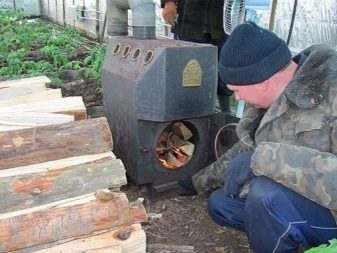Furnaces for greenhouses: the types and features of the device

When growing heat-loving plants in the climate of our country, it is sometimes not enough just a well-built greenhouse. In winter and at the beginning of spring, when the frost is especially strong, it may well need the help of the heating system.
It is clear that a full-fledged heating system, held in the greenhouse - this is not a cheap pleasure, and most gardeners have to look for alternative ways to maintain a constant temperature inside the greenhouse. One of these solutions is a greenhouse furnace.
Types of stoves
Furnaces for greenhouses are different. They may differ in the material from which they are made, in the type of fuel used, and in some other nuances, such as shape or size.Today, it is possible to purchase or even independently manufacture a furnace from a variety of materials, however, bricks and metal kilns are the most popular today. Metal furnaces are extremely difficult to do on their own, so, most likely, you will have to buy it in a special store.
There expects a huge selection of different types of metal furnaces for greenhouses, so it is worth considering the most popular of them, their pros and cons.
- "Potbelly stove" - This is probably the most popular type of stove of all. It is a barrel with a door welded to it, a heat sink pipe, a chimney and a lintel in the upper third. The “stove” is popular primarily because of its simplicity and low cost (most often, the stoves are made with their own hands from old barrels). Its only drawback is the need for constant control of fire, because without regular reloading of fuel, it goes out pretty quickly. By the way, in addition to wood and coal, "Burzhuyka" can work on sawdust.
- "Bubafonya" - This is an improved version of the stove-stove. It is arranged approximately as follows: the same barrel with a chimney, but already without a door on the side, instead of it a lid at the top is used.After the fuel is poured into it, a press is placed on top of it, an iron pancake with a hole in the middle and a hollow pipe welded to it. Oxygen enters through this pipe, and the press allows it to be distributed evenly, gradually descending along with the burning of fuel. Because of this, the fuel burns longer, it is necessary to load it less often and the heat is stored inside the furnace better, since it is not blown away by natural fines.
- "Vologda" extremely similar in its principle and structure to the “Burzhuyka”, but its main difference is that the barrel is not installed vertically, but placed horizontally, which allows to increase the area for fuel placement. Due to this, the furnace does not require constant supervision, and it is necessary to load fuel into it only 2-3 times a day. Often, "Vologda" is used to warm up the heating system, since its design allows you to connect pipes to it for water flow. Certain oven models can run on diesel, fuel oil and engine oil.
- Stove Butakova - This is an extremely powerful and expensive model. In its design, several heat supply pipes are provided at once, which significantly increases the amount of warm air coming from it.The furnace has a very high efficiency, but despite this, because of its power, it consumes a lot of firewood. It works exclusively on solid fuels, wood and coal.
- "Buleryan" - This is not a very popular model because of its high power and price. This furnace is most often used for heating large industrial greenhouses. Like the Butakova stove, it has several heat removal pipes at once. Even the smallest model lets through five cubes of warm air every minute. It works on wood, coal and sawdust, and certain models - and on liquid fuel.
- "Slobozhanka" similar to “Bubafonu”, as well as in it, firewood is loaded vertically, there is a press for tamping, but air enters the Slobozhanka from the bottom, and not from above, as in “Bubafon”. Its main advantage can be called the possibility of connecting the water circuit to create a complete heating system.
These are only the most popular models of greenhouse stoves, but there are others. And which of them to install in the greenhouse, decide each. You can make the oven yourself in the presence of tools for metal. Old barrels and pipes can be used as materials for it.You can make a small stove out of an empty gas cylinder by simply attaching doors and pipes to it to remove heat and smoke.
A brick oven is a bit more expensive than an iron one, but they look much more accurate, and it is easier and easier to work with them. In addition, you can fully show your ingenuity and imagination in its construction, having planned everything - from the size to the chimney system. Even if you do not want to build it yourself, you can tell the contractors what you want to get in the end, and they will try to adhere to this design. And also worth mentioning the furnaces for greenhouses, working on gas. Such a furnace is very difficult to build, which is why their prices are much higher. But the gas oven has a very high efficiency and is able to work for a long time without refueling.
Fuel options
As mentioned earlier, you can use different types of fuel for heating the greenhouse. Most often, of course, preference is given to wood and coal, but depending on certain conditions, there are better options.
- The first such option is sawdustwhich are excellent fuel available and with high efficiency.Most furnaces for greenhouses can work on sawdust, and if you live in a small settlement, then getting them is not a problem. You can contact the nearest sawmill or to someone who is engaged in logging firewood for the winter on their own. Usually after this there are quite a lot of sawdust that you need to collect and throw away. Most likely, they will only be glad that someone will “tidy up” behind them.
- An excellent option for kindling greenhouses can be and used engine oil. Of course, not all furnaces can operate on this type of fuel, but if there is a fleet or other transport companies nearby, then it makes sense to find a suitable furnace. Used oil has a very high efficiency, and the furnaces running on it do not require frequent refueling. All you need is to contact the owner of the fleet and ask for permission to take out the used oil.
This raw material is subject to disposal, therefore, most likely, it will only be glad that it will be freed from unnecessary trouble.
- A good alternative to oil can be fuel oil. Usually no one needs fuel oil remains in the locomotive depot or CHP.There you can try to borrow it, of course, with the permission of the authorities.
- Separately, it is worth to provide diesel as fuel for greenhouse furnaces. It also has a very high efficiency, but it is much harder to get it. It is suitable only for those who work on their own or have acquaintances who work in enterprises where a certain stock of diesel fuel is given out to employees, which they can manage independently. These companies include railway depots, collective farms and car parks.
- The least popular gas. Although it is extremely effective as a fuel, gas-fired stoves cost a lot of money and require constant attention, because a small opening is enough for gas to start leaking. And about what will happen if such a construction explodes and is not worth talking about.
Optimal choice
Now, knowing all the necessary information about the furnaces for the greenhouse, it is time to choose the one that suits the specific case. And then it all depends on what size the greenhouse, what fuel in the plans to use and how much the buyer is ready to give for the furnace. It is worth considering each criterion in order,and start with the size of the greenhouse. If the greenhouse is small in size, then a small stove like a stove will be enough for its heating.
The ideal option would be "Bubafonya" and "Vologda", as they are able to provide longer burning without refueling and do not have to run and fill it every half hour. If the greenhouse is large, then it would be better to use more powerful versions of the furnaces, like the Buleryana or the Butakov furnaces, since it is they that are distinguished by high power and efficiency. And it will also be a plus that they have different size variations, and the larger the area of the greenhouse, the greater must be the stove.
As for fuel, there is little choice. If it is possible to buy fuel oil, diesel, waste oil or sawdust for cheap, then preference should be given to them. If not, then only firewood or coal remains as an inexpensive and efficient fuel that anyone can buy.
If we talk about the price, then it is clear that the more powerful and efficient the furnace, the greater its price. The only thing that can be advised is to make the chimney not vertical, but to lead it through the entire greenhouse.Thus, the heat coming from the chimney will help to increase the area of the furnace, and, in addition, will improve the efficiency of traction. Many gardeners resort to such tricks if the size of the greenhouses is too large for a small furnace, but there are clearly fewer industrial options. And if there is an opportunity, you can make the oven yourself - it will cost much cheaper.
Important! One of the best options for furnaces for the greenhouse today is considered to be the central wood construction. It works on wood that is accessible to everyone, has high efficiency, is able to heat a greenhouse of considerable size and, importantly, it will not be difficult to build it yourself.
Central wood construction: the pros and cons
The central wood construction or as it is also called the long burning furnace is an ideal solution for heating medium-sized greenhouses. By design, it is similar to Bubaphone, but increased in size. Usually it is built of bricks and installed in the middle of the greenhouse. It works on wood or coal, but, despite this, it has a very high efficiency and can effectively heat even a large-sized greenhouse.Firewood should be thrown at it only once a day, and coal at all - once every five days.
But this design has several drawbacks.
- The need for frequent watering. The central wood construction heats the air very quickly, which is why it will always be dry in a greenhouse. Many plants do not tolerate such a climate and dry out quickly without regular watering. To partially compensate for the effect, experienced gardeners are advised to install several barrels of water near the stove.
- Uneven heat distribution. Due to the design of the air in the greenhouse will warm unevenly, directly at the furnace will always be much warmer. This will be especially noticeable in large greenhouses. This fact should be taken into account when planting plants and planting more heat-loving plants closer to the furnace, and not loving the heat - away.
As you can see, the central wood construction can be a very profitable solution for greenhouse owners, if we take into account all the nuances of its operation in time.
"Bubafonya"
Bubafonya is one of the best furnaces for small-sized greenhouses. Its design is simple and straightforward.but at the same time it allows to heat the greenhouse very efficiently, spending a minimum of resources and forces. Make it yourself will not be any difficulty. As materials, you can use the old barrel and some metal, which is likely to be found in the yard of every avid gardener, and its various drawings can be easily found on the Internet. It is worth understanding how the self-made “Bubafonya” is built.
Features and device
As mentioned earlier, the main feature of the stove-stove is an increased efficiency and a rare fuel load. This effect was achieved thanks to the vertical supply of oxygen and the press, which helps to efficiently distribute oxygen and remove the remnants of burned fuel.
When the press is lowered as the fuel burns through, all the ash passes through the holes between the pancake and the furnace walls, so it does not interfere with the oxygen freely flowing to the firewood.
Manufacturing
Although the Bubafoni device seems rather complicated, it is quite simple to make it with your own hands, especially if you already had an affair with metal blanks. To create it, you will need an iron barrel, a pipe with dimensions slightly larger than the height of the barrel,a chimney pipe and a sheet of metal from which to manufacture the press, doors and various minor components.
The following manufacturing instructions should be followed:
- the first thing you need to take a barrel and cut off its top, to save materials from it you can also make a future cover;
- there should be no gaps in the lower part of the barrel, but if there are, even if small, it is better to weld them;
- From a strong piece of metal, you need to cut a pancake with a diameter 4 cm smaller than the diameter of the barrel, and then in its center make a hole that is suitable for the existing pipe;
- Bottom of the circle should attach the corners or metal profile to create a gap between it and the fuel for the free passage of air;
- you need to weld the pipe and pancake to each other;
- in the lid for the barrel to make a hole slightly larger than the diameter of the pipe, the gap between them should be minimal, but at the same time the pipe should slide freely;
- in the bottom of the barrel is cut a hole for the ash door;
- it is necessary to make an ashtray door, weld canopies and fix it;
- on the side of the upper third of the barrel to make a hole for the chimney and weld it to it;
- the stove must stand firmly on the ground, if it does not want to do this on its own, then you can weld legs or supports to it.
That's all, “Bubafonya” is ready. As you can see, to make it yourself is not difficult at all, and all the labor expended will pay off many times in the future.
"Buleryan": distinctive features
Greenhouse stove "Buleryan" is not very popular among gardeners, but not because of design drawbacks or poor performance, but because of high power and price. Small private greenhouses simply do not need such power, so its purchase will be a waste of money. But then “Buleryan” is an ideal choice for heating large greenhouses.
It has enormous power, which is achieved through the installation of several heat removal pipes at once and a good oxygen supply system. As mentioned earlier, even the smallest model can produce five cubic meters of heated air every minute, and for larger models this figure can increase several times. Buleryan works mainly on solid fuels, but some of its modifications can work on liquid.
The efficiency of such a furnace is very high, but it will be necessary to load firewood into it quite often, because maintaining such power requires high fuel consumption.
In the next video you will find a review and manufacture of the Bubafonya furnace for the greenhouse.





